Analog electronics circuits miscellaneous
- In the circuit given below the transistor parameters are
VTN = 1 V, and kn = 36 µA/V2. If ID = 0.5 mA, V1 = 5 V and V2 = 2 V then the width-to-length ratio
i.e. W 
required in each transistor is L 
W 

W 

W 
L 1 L 2 L 3 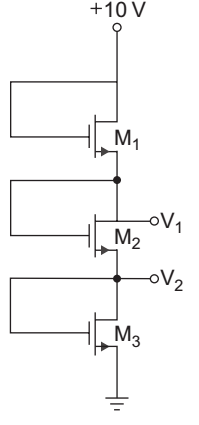
-
View Hint View Answer Discuss in Forum
For each transistor M1, M2 and M2
VGS = VDS i.e. VDS > VGS – VTN
Therefore all the transistor are in saturation Given that
VTN = 1 V
k′n = 36 µA/V2
ID = 0.5 mA
V1 = 5 VS V2 = 2 V
For transistor M3
V2 = 2V = VGS3
ID = 0.5 × 10–3= 1 36 × 10–6 
W 
. (2 – 1)2 2 L 3 after simplifying we get 
W 
= 27.8 L 3
For transistor M2,
VGS2 = V1 – V2 = 5 – 2 = 3 V
ID = 0.5 × 10–3= 36 × 10–6 
W 
(3 – 1)2 L 2 or 
W 
= 6.94 L 2
For transistor M1
VGS1 = 10 – V1 = 10 – 5 = 5 V
ID = 0.5 × 10–3= 1 36 × 10–6 
W 
. (5 – 1)2 2 L 1 or 
W 
= 1.74 L 1
Hence alternative (A) is the correct choice.Correct Option: A
For each transistor M1, M2 and M2
VGS = VDS i.e. VDS > VGS – VTN
Therefore all the transistor are in saturation Given that
VTN = 1 V
k′n = 36 µA/V2
ID = 0.5 mA
V1 = 5 VS V2 = 2 V
For transistor M3
V2 = 2V = VGS3
ID = 0.5 × 10–3= 1 36 × 10–6 
W 
. (2 – 1)2 2 L 3 after simplifying we get 
W 
= 27.8 L 3
For transistor M2,
VGS2 = V1 – V2 = 5 – 2 = 3 V
ID = 0.5 × 10–3= 36 × 10–6 
W 
(3 – 1)2 L 2 or 
W 
= 6.94 L 2
For transistor M1
VGS1 = 10 – V1 = 10 – 5 = 5 V
ID = 0.5 × 10–3= 1 36 × 10–6 
W 
. (5 – 1)2 2 L 1 or 
W 
= 1.74 L 1
Hence alternative (A) is the correct choice.
Direction: Consider the circuit shown below:
The both transistor have parameter as follows:
VTN = 0.8 V, kn = 30 ΩA/V2

-
If the ratio is 
W 
= 40 and 
W 
= 15, then V0 is: L 1 L 2
-
View Hint View Answer Discuss in Forum
According to question

W 
= 40 and 
W 
= 15 L 1 L 2
Again
Kn1 (VGS1 – VTN1 )2=Kn2 (VGS2 – VTN2 )2
40 (VGS1 – 0.8)2 = 15 (VGS2 – 0.8)2 `…(A)
VGS1 + VGS2 = 5 …(B)
from (A) and (B)
40 (VGS1 – 0.8)2 = 15 (5 – VGS1 – 0.8)2
8 [V2GS1 +.64 –1.6 VGS1] = 3 [17.64 + V2GS1 –8 VGS1]
5 V2GS1 + 11.2 VGS1 – 47.8 = 0
VGS1 = 2.09
V0 = 5 – VGS1
= 5 – 2.09 = 2.91 V
Correct Option: A
According to question

W 
= 40 and 
W 
= 15 L 1 L 2
Again
Kn1 (VGS1 – VTN1 )2=Kn2 (VGS2 – VTN2 )2
40 (VGS1 – 0.8)2 = 15 (VGS2 – 0.8)2 `…(A)
VGS1 + VGS2 = 5 …(B)
from (A) and (B)
40 (VGS1 – 0.8)2 = 15 (5 – VGS1 – 0.8)2
8 [V2GS1 +.64 –1.6 VGS1] = 3 [17.64 + V2GS1 –8 VGS1]
5 V2GS1 + 11.2 VGS1 – 47.8 = 0
VGS1 = 2.09
V0 = 5 – VGS1
= 5 – 2.09 = 2.91 V
- If the width-to-length ratios of M1 and M2 are:

W 
= 
W 
= 40 L 1 L 2
The output V0 is:
-
View Hint View Answer Discuss in Forum
For both transistor M1 and M2
VDS = VGS
∴ VDS > VGS – VTN therefore both the transistor are in saturation
ID1 = ID2
ID1 = Kn1 (VGS1 – VTN1 )2
= Kn2 (VGS2 – VTN2)2 …(A)
Kn1 = Kn2 and VTN1 = VTN2
on expanding equation
V2GS1 + V2TN1 – 2VGS1 = V2GS2 + V2TN2 – 2VGS2
or V2GS1 + V2GS2 = 2 (VGS1 – VGS2) …(B)
from given figure,
VGS1 + VGS2 = 5 …(C)
V2GS1 – (5 – VGS1 )2 = 2 (VGS1 – VGS1 + 5)
V2GS1 – 25 – V2GS1 + 10 VGS1 = 10
10 VGS1 = 35
or VGS1 = 3.5
VGS2 = 5 – VGS1 = 5 – 3.5 = 1.5 V
So, V0 = 5 – VGS1 = VGS2 = 1.5 V
Correct Option: A
For both transistor M1 and M2
VDS = VGS
∴ VDS > VGS – VTN therefore both the transistor are in saturation
ID1 = ID2
ID1 = Kn1 (VGS1 – VTN1 )2
= Kn2 (VGS2 – VTN2)2 …(A)
Kn1 = Kn2 and VTN1 = VTN2
on expanding equation
V2GS1 + V2TN1 – 2VGS1 = V2GS2 + V2TN2 – 2VGS2
or V2GS1 + V2GS2 = 2 (VGS1 – VGS2) …(B)
from given figure,
VGS1 + VGS2 = 5 …(C)
V2GS1 – (5 – VGS1 )2 = 2 (VGS1 – VGS1 + 5)
V2GS1 – 25 – V2GS1 + 10 VGS1 = 10
10 VGS1 = 35
or VGS1 = 3.5
VGS2 = 5 – VGS1 = 5 – 3.5 = 1.5 V
So, V0 = 5 – VGS1 = VGS2 = 1.5 V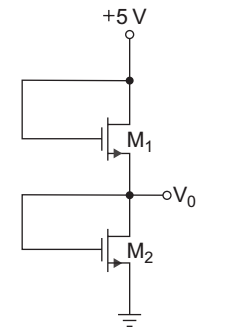
- The parameters for the transistor in circuit of fig. below are VTN = 2 V and Kn = 0.2 mA/V2. The power dissipated in the transistor is:
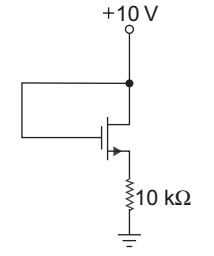
-
View Hint View Answer Discuss in Forum
From fig. since gate is connected to the drain. Hence transistor will always in saturation.
ID = 10 – VGS = Kn (VGS – VTn)2 10 kΩ
10 – VGS = 0.2 × 10–3 × 10 × 103 (VGS – 2)2
or 10 – VGS = 2 (VGS – 2)2
After solving quadratic equation, we get
VGS = – 0.27 V, 3.77 V VGS = – 0.27 is not possible since gate terminal is at 10 V. So, VGS = 3.77 V is taken
i.e. VGS = VDS = 3.77 VID = 10 – 3·77 = 0.623 mA 10 kΩ
Power = ID VDS = 0.623 × 10–3 × 3.77 = 2.35 mW
Correct Option: B
From fig. since gate is connected to the drain. Hence transistor will always in saturation.
ID = 10 – VGS = Kn (VGS – VTn)2 10 kΩ
10 – VGS = 0.2 × 10–3 × 10 × 103 (VGS – 2)2
or 10 – VGS = 2 (VGS – 2)2
After solving quadratic equation, we get
VGS = – 0.27 V, 3.77 V VGS = – 0.27 is not possible since gate terminal is at 10 V. So, VGS = 3.77 V is taken
i.e. VGS = VDS = 3.77 VID = 10 – 3·77 = 0.623 mA 10 kΩ
Power = ID VDS = 0.623 × 10–3 × 3.77 = 2.35 mW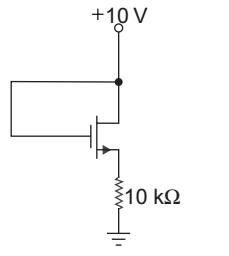
- The PMOS transistor shown below has parameters:
VTP = - 1.2 V, W = 20, and KP = 30 µA/V2 L
If ID = 0.5 mA and VD = – 3 V, then value of RS and RD are: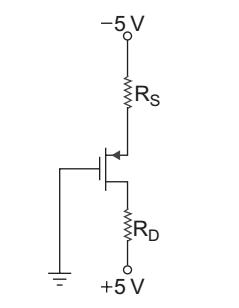
-
View Hint View Answer Discuss in Forum
NA
Correct Option: D
NA

